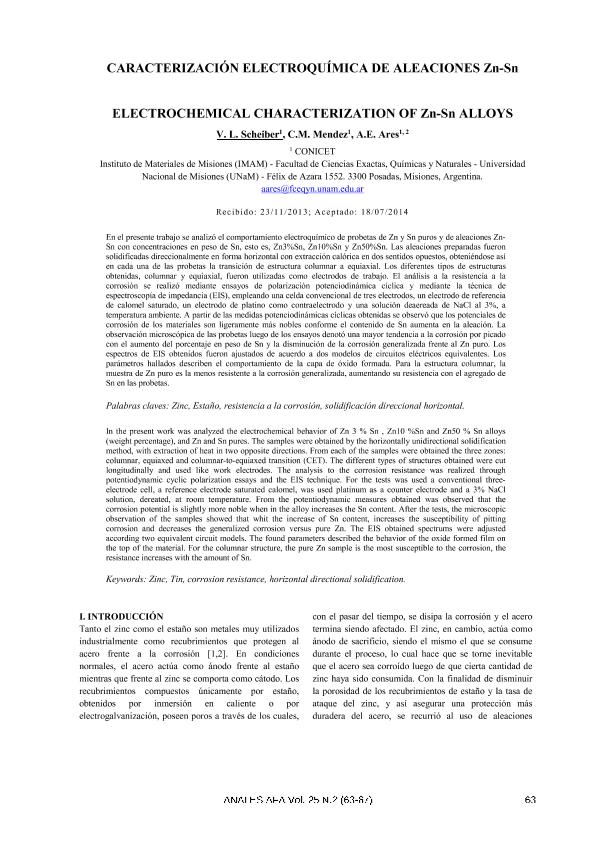Mostrar el registro sencillo del ítem
dc.contributor.author
Scheiber, V. L.
dc.contributor.author
Mendez, Claudia Marcela

dc.contributor.author
Ares, Alicia Esther

dc.date.available
2018-02-09T15:04:55Z
dc.date.issued
2014-07
dc.identifier.citation
Scheiber, V. L.; Mendez, Claudia Marcela; Ares, Alicia Esther; Caracterización electroquímica de aleaciones Zn-Sn; Asociación Física Argentina; Anales AFA; 25; 2; 7-2014; 63-67
dc.identifier.issn
0327-358X
dc.identifier.uri
http://hdl.handle.net/11336/36296
dc.description.abstract
En el presente trabajo se analizó el comportamiento electroquímico de probetas de Zn y Sn puros y de aleaciones Zn-Sn con concentraciones en peso de Sn, esto es, Zn3%Sn, Zn10%Sn y Zn50%Sn. Las aleaciones preparadas fueronsolidificadas direccionalmente en forma horizontal con extracción calórica en dos sentidos opuestos, obteniéndose asíen cada una de las probetas la transición de estructura columnar a equiaxial. Los diferentes tipos de estructurasobtenidas, columnar y equiaxial, fueron utilizadas como electrodos de trabajo. El análisis a la resistencia a lacorrosión se realizó mediante ensayos de polarización potenciodinámica cíclica y mediante la técnica deespectroscopía de impedancia (EIS), empleando una celda convencional de tres electrodos, un electrodo de referenciade calomel saturado, un electrodo de platino como contraelectrodo y una solución deaereada de NaCl al 3%, atemperatura ambiente. A partir de las medidas potenciodinámicas cíclicas obtenidas se observó que los potenciales decorrosión de los materiales son ligeramente más nobles conforme el contenido de Sn aumenta en la aleación. Laobservación microscópica de las probetas luego de los ensayos denotó una mayor tendencia a la corrosión por picadocon el aumento del porcentaje en peso de Sn y la disminución de la corrosión generalizada frente al Zn puro. Losespectros de EIS obtenidos fueron ajustados de acuerdo a dos modelos de circuitos eléctricos equivalentes. Losparámetros hallados describen el comportamiento de la capa de óxido formada. Para la estructura columnar, lamuestra de Zn puro es la menos resistente a la corrosión generalizada, aumentando su resistencia con el agregado deSn en las probetas.
dc.description.abstract
In the present work was analyzed the electrochemical behavior of Zn 3 % Sn, Zn10 %Sn and Zn50 % Sn alloys (weight percentage), and Zn and Sn pures. The samples were obtained by the horizontally unidirectional solidification method, with extraction of heat in two opposite directions. From each of the samples were obtained the three zones: columnar, equiaxed and columnar-to-equiaxed transition (CET). The different types of structures obtained were cut longitudinally and used like work electrodes. The analysis to the corrosion resistance was realized through potentiodynamic cyclic polarization essays and the EIS technique. For the tests was used a conventional threeelectrode cell, a reference electrode saturated calomel, was used platinum as a counter electrode and a 3% NaCl solution, dereated, at room temperature. From the potentiodynamic measures obtained was observed that the corrosion potential is slightly more noble when in the alloy increases the Sn content. After the tests, the microscopic observation of the samples showed that whit the increase of Sn content, increases the susceptibility of pitting corrosion and decreases the generalized corrosion versus pure Zn. The EIS obtained spectrums were adjusted according two equivalent circuit models. The found parameters described the behavior of the oxide formed film on the top of the material. For the columnar structure, the pure Zn sample is the most susceptible to the corrosion, the resistance increases with the amount of Sn.
dc.format
application/pdf
dc.language.iso
spa
dc.publisher
Asociación Física Argentina

dc.rights
info:eu-repo/semantics/openAccess
dc.rights.uri
https://creativecommons.org/licenses/by-nc-sa/2.5/ar/
dc.subject
Zinc
dc.subject
Resistencia a La Corrosión
dc.subject
Solidificación Direccional Horizontal.
dc.subject
Estaño
dc.subject
Tin
dc.subject
Corrosion Resistance
dc.subject
Horizontal Directional Solidification
dc.subject.classification
Otras Ciencias Químicas

dc.subject.classification
Ciencias Químicas

dc.subject.classification
CIENCIAS NATURALES Y EXACTAS

dc.title
Caracterización electroquímica de aleaciones Zn-Sn
dc.title
Electrochemical characterization of Zn-Sn alloys
dc.type
info:eu-repo/semantics/article
dc.type
info:ar-repo/semantics/artículo
dc.type
info:eu-repo/semantics/publishedVersion
dc.date.updated
2018-02-07T20:36:59Z
dc.identifier.eissn
1850-1168
dc.journal.volume
25
dc.journal.number
2
dc.journal.pagination
63-67
dc.journal.pais
Argentina

dc.journal.ciudad
Tandil
dc.description.fil
Fil: Scheiber, V. L.. Consejo Nacional de Investigaciones Científicas y Técnicas; Argentina
dc.description.fil
Fil: Mendez, Claudia Marcela. Universidad Nacional de Misiones; Argentina
dc.description.fil
Fil: Ares, Alicia Esther. Consejo Nacional de Investigaciones Científicas y Técnicas. Centro Científico Tecnológico Conicet - Nordeste. Instituto de Materiales de Misiones. Universidad Nacional de Misiones. Facultad de Cs.exactas Químicas y Naturales. Instituto de Materiales de Misiones; Argentina
dc.journal.title
Anales AFA

dc.relation.alternativeid
info:eu-repo/semantics/altIdentifier/url/http://anales.fisica.org.ar/journal/index.php/analesafa/article/view/1953
Archivos asociados
